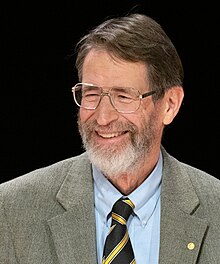George P. Smith
George Pearson Smith (born March 10, 1941 in Norwalk , Connecticut ) is an American biologist and professor emeritus at the University of Missouri . He was awarded a Nobel Prize in Chemistry in 2018 .
Smith is considered to be the inventor of the phage display method . In his fundamental work from 1985 he showed that it is possible to incorporate arbitrary DNA sequences for peptides into a bacteriophage , which then presents the peptide on its coat protein. Bacteriophages attack E. coli host cells in order to replicate. Smith started from the observation that the gene III of the filamentous phage (filamentous phage) fd has a modular structure, so that it was possible to incorporate foreign DNA sequences there without losing the replication function of the phage. Smith also predicted that it would be possible to produce a library of phage displays with random amino acid arrangements in the peptides to identify epitopes of an antibody and that phage displays could be used for vaccine production.
In 1984 he also tried to patent the idea, but did not pursue it any further, in contrast to Robert Ladner, who came up with the idea of the phage display independently and in 1988 submitted a detailed 350-page patent for the Dyax company in which he was Chief Scientific Officer. After that, Smith did not add the Ladner patent application. He is even quoted as saying that Ladner is an innovative scientist who receives too little recognition.
Smith earned a bachelor's degree in biology from Haverford College in 1963 . After a brief stint as a high school teacher and laboratory technician, he earned a Ph.D. from Edgar Haber at Harvard University in 1970. in bacteriology and immunology . As a postdoctoral fellow , he worked with Oliver Smithies at the University of Wisconsin – Madison . Since 1975 he has been a faculty member at the University of Missouri at Columbia , Missouri . He became a Curator's Professor at the University of Missouri in 2000 . In 2015 he finally retired.
In 2001 Smith became a member of the American Association for the Advancement of Science and in 2020 the National Academy of Sciences . In 2007 he received the Promega Biotechnology Research Award from the American Society for Microbiology .
Fonts (selection)
- George P. Smith: Filamentous fusion phage: novel expression vectors that display cloned antigens on the virion surface. In: Science . Volume 228, 1985, pp. 1315-1317
- SF Parmley, GP Smith: Antibody-selectable filamentous fd phage vectors: affinity purification of target genes. In: Genes. Volume 73, 1988, pp. 305-318.
- JK Scott, GP Smith: Searching for peptide ligands with an epitope library. In: Science . Volume 249, 1990, pp. 386-390.
- Smith et al. a .: Libraries of Peptides and Proteins Displayed on Filamentous Phage. In: Methods in Enzymology . Volume 217, 1993, pp. 228-257.
- Smith: Surface Presentation of Protein Epitopes using Bacteriophage Expression Systems. In: Current Opinion in Biotechnology. Volume 2, 1993, pp. 668-673.
- George P. Smith, Valery A. Petrenko: Phage Display. In: Chemical Reviews . Volume 97, 1997, p. 391, doi: 10.1021 / cr960065d .
Web links
- University of Missouri website (missouri.edu)
- Press release on the Nobel Prize in Chemistry 2018 (nobelprize.org)
- CV (as of 2004) (wustl.edu)
Individual evidence
- ^ GP Smith: Filamentous Fusion Phage: Novel Expression Vectors That Display Cloned Antigens on the Virion Surface . In: Science . tape 228 , no. 4705 , June 14, 1985, pp. 1315-1317 , doi : 10.1126 / science.4001944 .
- ↑ William Wells: Phage on display. In: Chemistry & Biology. Volume 4, 1997, p. 977.
- ↑ Promega Biotechnology Research Award Past Laureates. (No longer available online.) In: asm.org. Archived from the original on October 3, 2018 ; accessed on October 3, 2018 (English).
| personal data | |
|---|---|
| SURNAME | Smith, George P. |
| ALTERNATIVE NAMES | Smith, George Pearson |
| BRIEF DESCRIPTION | American biologist from the University of Missouri |
| DATE OF BIRTH | March 10, 1941 |
| PLACE OF BIRTH | Norwalk , Connecticut |
